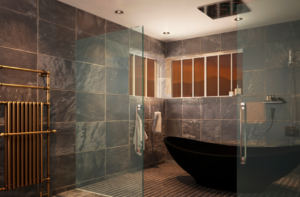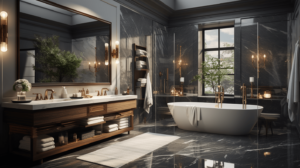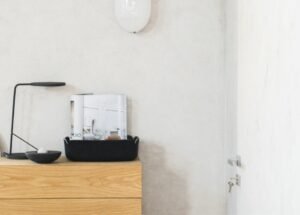What is a wet room bathroom?
A wet room bathroom eliminates traditional shower enclosures, completely waterproofing the space for a streamlined, open design. It involves seamless floor systems, with precise slopes towards drains, ensuring effective water management. You’ll need to seal floors and walls with waterproof membranes diligently. The aesthetic is minimalist, offering more space and easy accessibility, particularly crucial for mobility issues. Maintenance becomes easier, but remember, adequate ventilation is crucial to prevent dampness issues. This setup can be installed on any floor of your home, creating a cohesive look. Delving deeper, you’ll discover various designs and practical tips to ensure your wet room remains both stylish and functional.
Key Points
- Wet rooms are bathrooms that are completely waterproofed, without the usual shower enclosures or trays.
- They have flat floor systems and effective drainage for a smooth appearance.
- The design provides easy access, making them ideal for those with mobility problems.
- The installation involves waterproofing walls and floors with membranes to avoid water damage.
- Wet rooms can enhance the value of a property by providing a contemporary and accessible bathroom design.
Defining Wet Room Bathrooms
While it may seem like a trendy innovation, a wet room bathroom, fully waterproofed and without the traditional shower enclosure, offers both sleek design and practical benefits, guaranteeing water drains away efficiently through a flush floor system. This unique feature not only improves the aesthetic appeal of your bathroom but is also a proof of advanced waterproofing technologies that protect your home against water damage.
You’ll find that installing a wet room involves sealing the walls and floors with a waterproof membrane, a critical step that requires meticulous attention to detail. This barrier assures that water doesn’t seep into the structure of your home, safeguarding against potential damage. The absence of a shower tray means the shower area blends seamlessly with the rest of the room, contributing to a more spacious and open feel.
For those considering a wet room, it’s essential to recognise the importance of proper drainage. The flush drain within the shower area is designed to handle water flow efficiently, preventing any standing water that could pose slip hazards. Additionally, selecting slip-resistant flooring can improve safety, ensuring a practical and stylish wet room bathroom that meets the needs of every family member, regardless of mobility.

Key Differences: Wet Rooms Vs. Shower Rooms
Understanding the distinct features between wet rooms and shower rooms is key when planning your bathroom renovation for a functional and stylish space. Wet rooms are characterised by their flush, level shower area, which contrasts sharply with the raised trays found in traditional shower rooms. This fundamental difference not only affects the appearance, creating a contemporary and sleek space in wet rooms, but also impacts functionality, offering increased accessibility.
The open, fully tiled design of a wet room eliminates the need for an enclosed shower space, a common feature in shower rooms. This openness provides a minimalist look and maximises the perceived size of the bathroom, making wet rooms particularly suitable for both small and large spaces. On the practical side, the absence of barriers makes wet rooms easier to enter and exit, especially for those with mobility issues, offering a level of flexibility that shower rooms can’t match.
When considering a wet room, it’s also important to note that they can be installed on any floor of your home, ensuring a cohesive look across all bathrooms. This versatility, combined with the design’s modern appeal, makes wet rooms an attractive option for renovating any bathroom space.
Benefits of Choosing a Wet Room
Opting for a wet room not only improves the aesthetic appeal of your home but also simplifies maintenance with its seamless design. The absence of shower trays and cubicles means there are fewer spaces for dirt and grime to accumulate, making it easier to keep clean. This design, with minimal lines and an open-plan approach, greatly reduces the time and effort required for upkeep.
Wet rooms are also incredibly accessible. Without the barriers of traditional shower cubicles or bathtubs, they offer an inclusive solution for family members of all ages and abilities. This feature is particularly beneficial for those with mobility issues, making showering safer and more comfortable.
The versatility in design is another standout benefit. You’re not limited to standard bathroom layouts, allowing for customisation that can include luxurious finishes and unique features that suit your personal taste and requirements. This adaptability means wet rooms can be installed in virtually any size of space, maximising the use of small areas or enhancing larger ones.
Lastly, installing a wet room can significantly increase the value of your property. Their modern, luxurious feel and practical benefits make them a desirable feature for potential buyers, offering you a good return on investment.

Potential Drawbacks to Consider
Despite the numerous benefits wet rooms offer, it’s important to weigh the potential drawbacks before making a decision. One notable concern is the challenge of keeping soft furnishings dry due to the open design. You’ll need to be strategic in the placement of towels, bath mats, and other fabric items to avoid them becoming saturated with every shower taken. This might mean investing in essential storage solutions or ensuring textiles are kept well away from the shower area.
Moreover, the lack of enclosure can lead to your wet room becoming steamy and damp, especially in smaller spaces. This not only creates a potentially uncomfortable environment but can also encourage mould growth if not properly managed. Implementing critical ventilation is vital; this may mean installing a high-quality extractor fan or ensuring there’s sufficient natural airflow to help control humidity levels.
Design and Accessibility Features
Wet rooms offer unparalleled accessibility, thanks to their crucial barrier-free design and sloping floors that ensure efficient water drainage. This layout eliminates the need for a traditional shower tray, creating a seamless and contemporary look that’s not only attractive but highly functional. The open arrangement and absence of barriers make these spaces ideal for individuals with disabilities or anyone who may struggle with conventional bathroom setups.
When planning your wet room, it’s essential to incorporate slip-resistant flooring to improve safety. This feature isn’t just a practical necessity; it’s a key element in ensuring the room is accessible and safe for all users, especially for those with reduced mobility. Given the room’s open layout, selecting suitable materials that are both water-resistant and slip-resistant can greatly reduce the risk of accidents.
Furthermore, the design should consider the placement of support bars and seats for those who may require them. Thoughtfully positioned, these elements can offer further assistance and comfort, transforming the bathroom into not only a functional space but also a haven of ease and accessibility. Keep in mind, a well-planned wet room not only caters to the aesthetic and practical needs but also significantly improves the quality of life for individuals facing mobility challenges.
Installation Process Overview
Starting the installation of a wet room demands thoughtful consideration and planning to ensure the area is adequately waterproofed and visually appealing. You’ll need to focus on creating a seamless space where the shower area integrates perfectly with the rest of the room. This means installing a flush drain system that guarantees water flows away efficiently, preventing any pooling.
The key to a successful wet room lies in the waterproofing. Walls and floors must be meticulously sealed with a waterproof membrane. This is vital to protect your home from water damage and maintain the integrity of the wet room. It’s not just about slapping on some sealant; it’s about ensuring every inch of the space is 100% watertight.
Given the technicalities involved, it’s wise to seek professional help. A qualified installer can ensure that the shower area is at the same level as the rest of the floor, achieving that sleek, contemporary look while ensuring practicality and safety. They’ll also navigate the complexities of waterproofing, preventing leaks and moisture issues that could compromise your home’s structure. Remember, a wet room isn’t just a stylish addition to your home—it’s a precision-engineered space designed for functionality and durability.
Cost Analysis and Budgeting
Understanding the cost factors involved in installing a wet room bathroom is essential to managing your budget effectively. The price range of £3000 to £12000 highlights the importance of thorough planning and research. Factors like room size, choice of materials, and labour have a significant impact on your expenses. Opting for high-quality, non-porous tiles such as slate or marble, though initially more costly, guarantees durability and maintains the essential waterproofing your wet room necessitates.
Incorporating elements like underfloor heating not only adds to the initial cost but also requires periodic maintenance, such as tile sealing, to prevent water damage. It’s important to budget not just for the installation but for the ongoing care of your wet room. Regular maintenance tasks, including leak checks, tile cleaning, and mould management, are crucial to safeguard your investment.
Hiring qualified professionals is a non-negotiable aspect of ensuring a successful and cost-effective installation. Skimping on expertise can lead to costly mistakes and damage. Remember, your goal is to create a functional, stylish space without unnecessary financial strain. With smart planning and budgeting, you can achieve a wet room bathroom that meets both your aesthetic and practical needs.
Maximising Space and Aesthetics
By removing the need for a separate shower enclosure, you are not only maximising the spatial layout of your bathroom but also enhancing its modern aesthetic appeal. The open-plan design inherent in wet rooms creates the impression of a larger space, which is particularly effective in small bathrooms where every inch is important. This seamless integration of the shower into the overall room not only simplifies the visual appearance but also provides a sleek, minimalist look that is at the forefront of contemporary bathroom design.
When designing your wet room, consider selecting materials and finishes that reflect light, as this can further enhance the feeling of space. For example, large-format tiles reduce the number of grout lines, creating a more cohesive and expansive visual impact. Moreover, incorporating features such as wall-mounted fixtures can elevate the minimalist aesthetic while also contributing to the efficient use of space.
Waterproofing and Maintenance Tips
Securing the long-term durability of your wet room depends on the correct waterproofing and regular maintenance, which are essential steps that must not be ignored. The foundation of a resilient wet room lies in its thorough waterproofing. This entails ensuring that every part of your walls and floors is covered with a high-quality waterproof membrane. It’s not only about preventing leaks; it’s about protecting your home’s structure from potential water damage.
To maintain this protection, you need to be proactive. Keep a regular check for any signs of leaks or wear in the waterproof seal. Dealing with these issues promptly can save you from expensive repairs later on. When it comes to your choice of tiles, go for non-porous materials such as slate or marble. These not only enhance the visual appeal of your wet room but also reduce the need for maintenance. Porous tiles can retain moisture, leading to the growth of mould and mildew, so choosing the right material is crucial.
Remember that underfloor heating systems, a common feature in wet rooms, also require periodic inspections. The tiles above this heating system should be adequately sealed to ensure they remain in good condition and functional. This not only enhances the warmth and comfort of your wet room but also prolongs the lifespan of the waterproofing components underneath.
Top Trends in Wet Room Designs
After exploring waterproofing and maintenance tips, let’s focus on the latest trends in wet room designs that can improve your bathroom’s functionality and style. Incorporating natural elements like wood and stone isn’t only a nod to modern aesthetics but also brings a sense of warmth and relaxation into the space. These materials must be properly sealed and maintained to withstand the wet room’s humid environment.
Glass partitions have surged in popularity, offering an elegant way to define the shower area without sacrificing the open feel that’s characteristic of wet room designs. They allow light to flow freely, making the space appear larger and more inviting. When selecting glass, consider frosted or tinted options for added privacy without losing the benefits of openness.
Lighting plays an important role in setting the right ambience. LED strips under benches or along the walls can create a soft glow, improving the tranquil atmosphere. Pendant lights, when placed strategically, can serve as a focal point and add a touch of sophistication.
Incorporating plants into your wet room design isn’t just about aesthetics; it’s also about creating a fresher, more invigorating environment. Opt for species that thrive in high humidity and can help purify the air, adding a lively splash of green to your bathroom oasis.
Adding Value to Your Property
Installing a wet room bathroom can enhance your property’s value by up to 5%, making it a wise investment for homeowners looking to take advantage of modern design trends. The attraction of a wet room lies in its contemporary design and functionality, which act as significant selling points. This kind of bathroom isn’t just about visual appeal; it’s about creating a space that’s both practical and luxurious, appealing to contemporary homebuyers who appreciate style and usefulness.
To maximise the value added by a wet room, you’ll need to focus on quality waterproofing, efficient drainage, and slip-resistant flooring. These technical details make sure that your wet room isn’t only stylish but also safe and long-lasting. Remember, the key to a valuable upgrade lies in its execution. Utilising professional design and construction services can help you achieve a customised wet room design that stands out, further boosting your property’s market appeal.
Getting Started With Your Wet Room
Before delving into the construction of your wet room, it’s important to understand that proper planning and precision are key to avoiding costly mistakes and guaranteeing a seamless, functional design. Initially, you’ll need to focus on fully waterproofing the space. This involves sealing both the walls and floor with a waterproof membrane, a critical step that prevents water damage and guarantees the longevity of your wet room. It’s not just about applying a layer; you must make sure of complete coverage and proper sealant application to avoid leaks.
Next, consider the drainage system. Wet rooms require a flush drain within the shower area, carefully positioned to ensure water flows away efficiently. This isn’t just a practical element; it dictates the slope of your floor, which must be subtly angled to direct water towards the drain. Precision here is essential to prevent standing water and ensure a dry, safe surface outside the immediate shower area.
Lastly, removing barriers such as shower trays or cubicles not only modernises the space but improves accessibility for everyone in your home. By integrating these elements with attention to detail and a focus on functionality, you’ll create a wet room that’s both stylish and practical, adding value and appeal to your property.
Regularly Asked Queries
What are the disadvantages of a wet room?
You may encounter challenges such as dampness, difficulty in keeping soft furnishings dry, and potential slip hazards. Adequate ventilation and design are crucial to address these issues, guaranteeing that your stylish choice does not compromise practicality or safety.
What makes a bathroom a wet room?
To create a wet room in your bathroom, you will need to waterproof the entire space, remove any shower enclosures, and ensure that the floor has a slight slope towards a drain. The aim is to create an open, seamless shower area.
Do you have a toilet in a wet room?
Yes, you can have a toilet in a wet room. It is usually placed away from the shower to prevent splashes, making the most of the space and functionality. Ensure adequate waterproofing and ventilation to deal with moisture and keep hygiene levels high.
What is the difference between a wet room and a bathroom?
You might be wondering how a wet room differs from a typical bathroom. Essentially, it's about the layout and waterproofing. Wet rooms do not have shower trays or cubicles, making them more accessible and sleeker in design.



